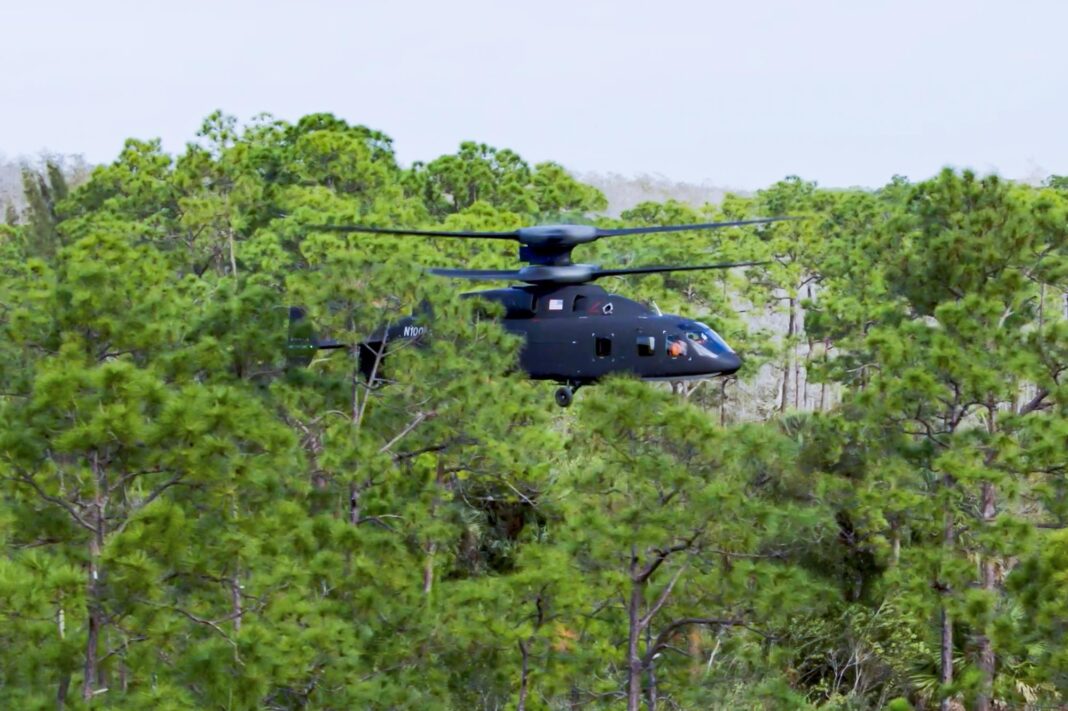Lockheed Martin Sikorsky-Boeing’s SB-1 Defiant high-speed takeoff and landing aircraft successfully completed FLRAA program mission profile test flights, including confined area landings and low-level flight operations.
These flights further validate the DEFIANT’s relevance to the US Army’s mission, providing agility over the target area (also known as the «X»), and enhanced air-to-air survivability, all while reducing pilot workload.
«We thoroughly demonstrated DEFIANT’s ability to execute the FLRAA mission profile by flying at 236 knots on level flight, then reducing thruster boost to rapidly decelerate as we approached the non-enhanced, confined landing zone,» said Bill Fell, DEFIANT’s Chief Flight Test Pilot at Sikorsky and retired U.S. Army Master Aviator. «This type of level flight deceleration enabled us to maintain situational awareness and see the landing area throughout the approach and touchdown without the typical nose-up helicopter deceleration. This confined area was extremely narrow, forcing us to delay our descent to almost the landing site, followed by a near-vertical descent. We landed the DEFIANT precisely on target with little effort by descending into this narrow hole while maintaining clearance on all sides.»
The SB11 DEFIANT is the technological demonstrator proving the transformative capabilities of the DEFIANT X weapon system, the Sikorsky-Boeing team’s bid for the U.S. Army’s Future Long-Range Assault Aircraft (FLRAA) competition as part of the U.S. Army’s Future Vertical Lift program. Army’s Future Vertical Lift program.
Using the DEFIANT X will enable aircrews to fly low and fast through complex terrain, where Army aviators spend most of their time. It will expand the capabilities of Army aviation on the modern battlefield and is designed to occupy the same footprint as a BLACK HAWK. With the DEFIANT X, the U.S. Army will deliver troops and cargo into future combat with twice the range of today’s conventional helicopter fleet.
«It’s what we call «rapidly building combat power,» and aircraft like the DEFIANT X can do that,» said Tony Crutchfield, retired U.S. Army lieutenant general and now Vice President of Army Systems at Boeing. «In the Pacific, it’s even more critical because the lines of operation are going to be dispersed over a wide area; you’re going to have these small bases and supply lines that are going to be located on ships or on islands. So you’re going to be looking to move more assets, maneuver in confined terrain, and survive to build that combat power faster than your adversary, so you can win.»
The DEFIANT X incorporates Sikorsky’s X2™ technology to operate at high speeds while maintaining low-speed handling qualities. This critical capability provides pilots with increased maneuverability and survivability in high-threat environments, allowing them to penetrate enemy defenses while reducing exposure to enemy fire. The DEFIANT X’s X2 coaxial rotor system and pusher propeller enable a high degree of maneuverability in and around the target (the «X»), which is also directly related to survivability.
DEFIANT achievements include:
- Turns of more than 60 degrees.
- Demonstrating mission-relevant payload capability by lifting a 5,300 lb (2,404 kg) external load from the Guided Multiple Launch Rocket System (MRLS)
- Exceeded 245 knots of level flight speed (in testing reached 247 knots, or 457 km/h)
- Demonstration of level 1 agility at low speed with fly-by-wire controls
- Integration of U.S. Army test pilots into Defiant program
- Based on Collier Award-winning X2 technology







